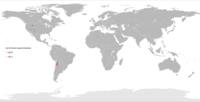
Photo from wikipedia
Abstract The Quaternary red clay (QRC) is one of the typical terrestrial sediments in southern China which contains abundant palaeoclimatic information. A natural QRC outcrop, named the Jingxian red clay… Click to show full abstract
Abstract The Quaternary red clay (QRC) is one of the typical terrestrial sediments in southern China which contains abundant palaeoclimatic information. A natural QRC outcrop, named the Jingxian red clay section (JRCS), was developed in Jingxian City on the northern piedmont of Mt. Huangshan, offering a valuable archive for long-term palaeoclimatic study from a southern China perspective. The objective of this study is to reveal palaeoclimatic information of regional precipitation from the JRCS and its correlation with the East Asian summer monsoon (EASM) intensity, using grain-size measurements combined with dating via Electron Spin Resonance (ESR) and palaeomagnetism. The results indicate that: (1) Ten palaeoclimatic wetter periods (PWPs) designated as PWPI to PWPX from top to bottom were detected from the grain-size analysis results of the upper 9.4 m JRCS. These PWPs span a period from approximately 840 ka ago to present; (2) three PWPs (PWPVIII to PWPX) were basically determined to approximately 612–690, 720–762 and 792–822 ka ago, basically corresponding to China loess layers of L6, L7 and L8 and deep-sea isotope stages of MIS16, MIS18 and MIS20, respectively. Data suggests that the PWPs in the study area were observed mainly during glaciations; (3) regional precipitation in the study area should be negatively related to the EASM intensity since approximately 840 ka ago as a result of variations in North Hemisphere solar insolation and uplifts of the Tibetan Plateau; (4) the modern anti-phase of monsoonal rainfall at glacial-interglacial timescales seemed to have existed between northern China and southern China since the late Early Pleistocene (approximately 840 ka ago).
Journal Title: Quaternary International
Year Published: 2019
Link to full text (if available)
Share on Social Media: Sign Up to like & get
recommendations!